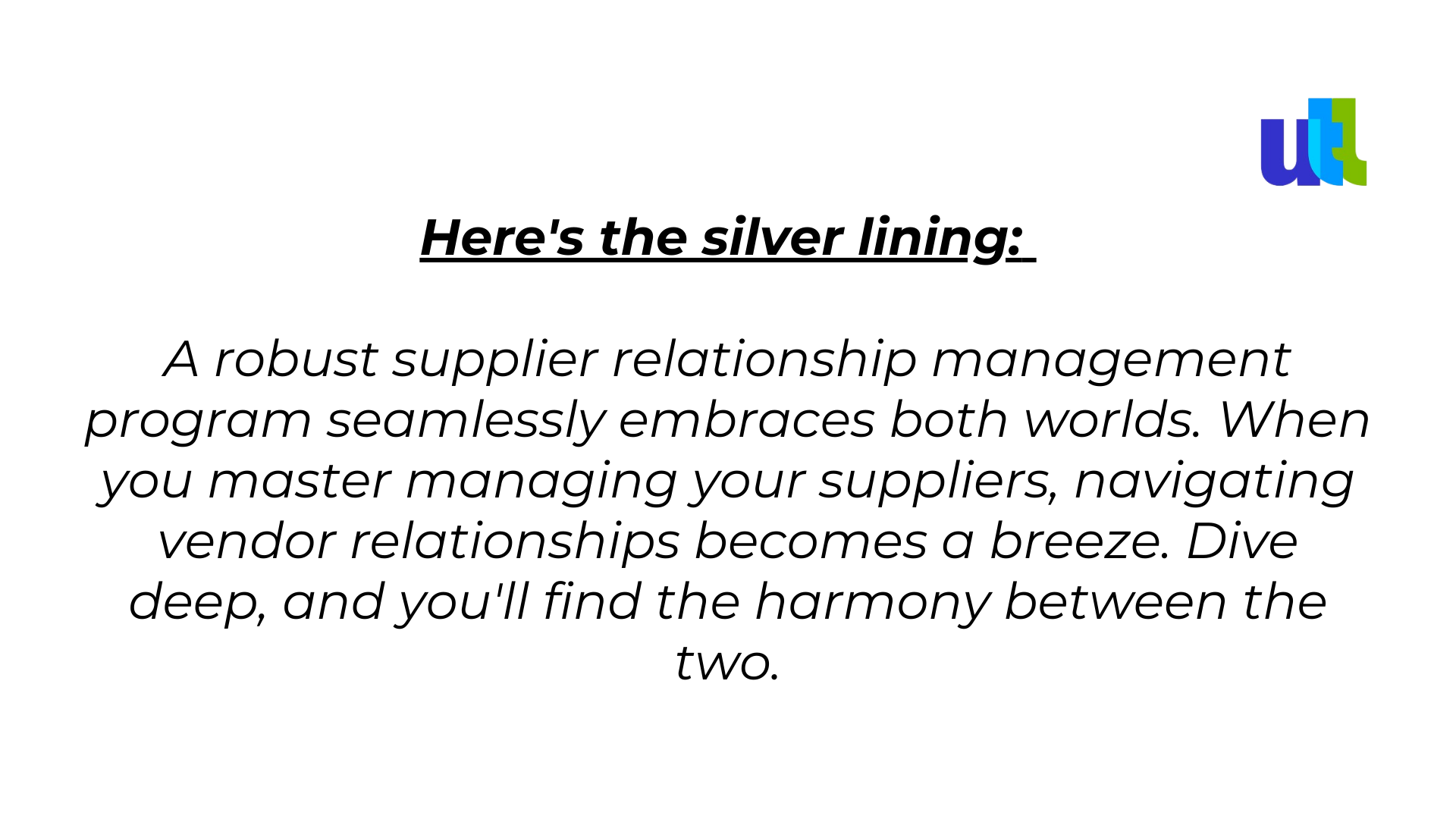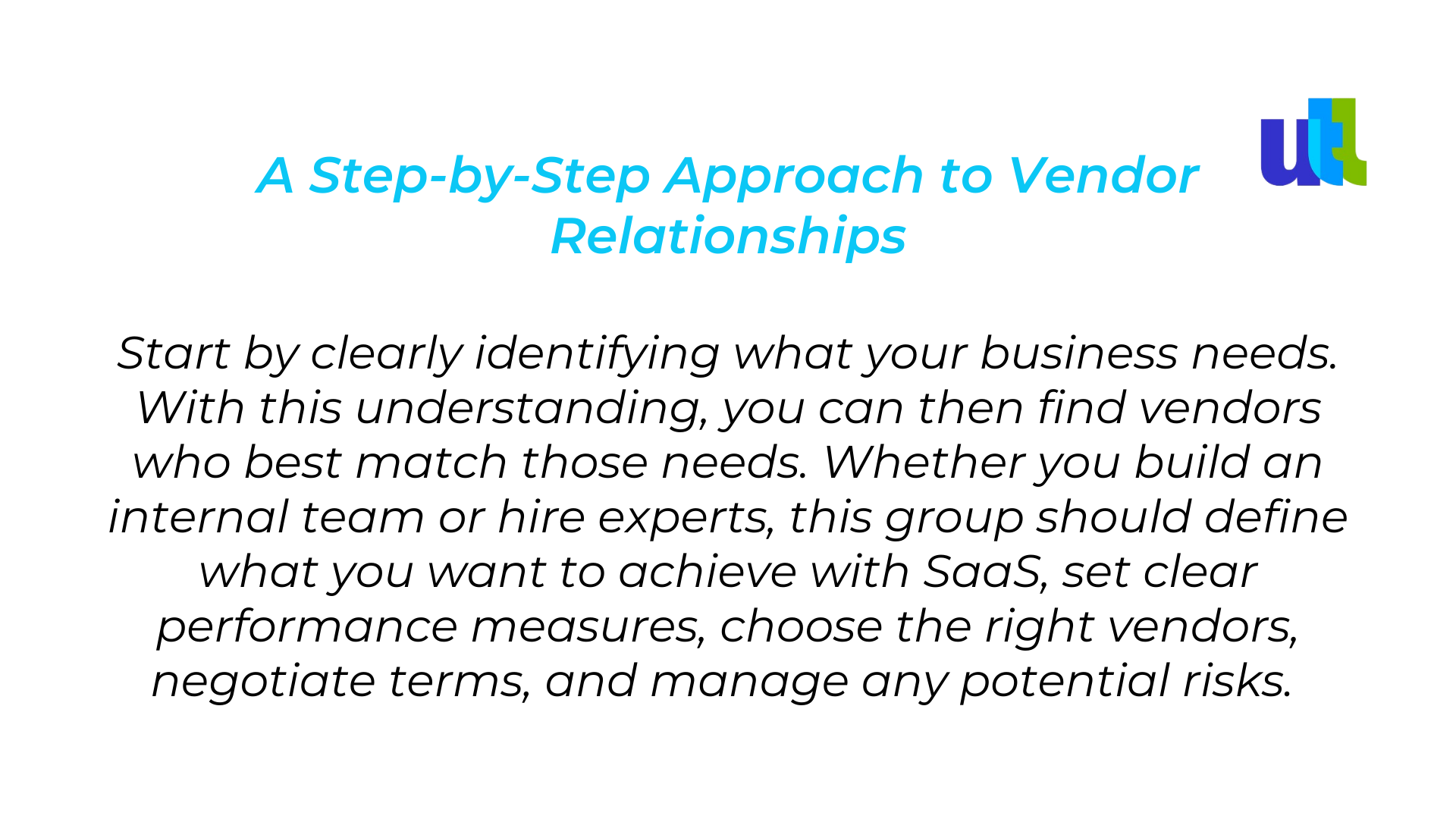Nearly half of all vendor collaborations—47% to be precise—stop progressing.
Why? A glaring oversight: ineffective vendor relationship management programs. As we navigated the digital landscape in 2022, companies reported an impressive 4,000 app-to-person connections on average and a 50% surge in SaaS expenditures. Furthermore, the significance of SaaS integrations has magnified, showing a consistent annual growth of at least 18% over the past three years, a trend projected to endure until 2030. While these numbers hint at the vast opportunities awaiting, they also underscore potential pitfalls. Vendor performance mishaps loom large, threatening to disrupt supply chains and jeopardize operations.
Navigating this intricate web requires meticulous vendor relationship management. The objective? To optimize software investments, enhance operational efficiency, minimize wastage, and fully leveraging your IT solutions. With nearly half of all vendor collaborations stumbling, often due to suboptimal vendor management approaches, it's evident that a one-size-fits-all strategy doesn't cut it. Factors ranging from the nature of the vendor to purchase quantities play a role in shaping effective strategies.
As we journey through this topic, we'll delve into the nuances of vendor relationships and underline the need for a shift—from conventional methods to innovative, collaborative practices for a brighter, integrated future.
Mastering vendor relationships
Vendor relationship management (VRM) isn't just about maintaining a cordial rapport with suppliers; it's the backbone of successful business collaboration. While pleasant interactions simplify operations, VRM's essence lies much deeper, influencing layers of both purchasing and selling entities.
Gartner defines vendor relationship management as a discipline that "empowers organizations to optimize costs, elevate service quality, and navigate risks, thus deriving amplified value from vendors throughout the deal's journey."
So, how does VRM achieve this breadth of influence? Picture this: By stratifying suppliers based on their potential risk and profitability impact, businesses can pinpoint opportunities for enhancing cost-efficiency, risk resilience, and overall value. VRM is the strategic pivot that fosters profound buyer-supplier ties, anchored in mutual aspirations and trust. An adept VRM process ushers in countless advantages, from elevating quality standards and reducing total cost of ownership (TCO) to sparking innovations and streamlining data exchange.
Why vendor relationship management is vital
In the dynamic world of technology procurement Vendor Relationship Management (VRM) stands out as a cornerstone of success. It's not just about cost-efficiency—though VRM plays a significant role there. It's about risk mitigation, service enhancement, and fostering symbiotic partnerships that propel both parties forward. Embracing a dedicated VRM solution can amplify these benefits, turning good relationships into great ones. The secret? Maintain transparency, conduct comprehensive annual reviews, and deeply understand your vendor's business dynamics. But a word to the wise: the jargon in the industry can sometimes be a maze. For instance, "vendor" and "supplier" often get tossed around interchangeably, yet their definitions might differ based on your organization's perspective.
Vendor vs. supplier: What's the difference?
While many might use terms “vendor” and “supplier” interchangeably, there's a subtle distinction worth noting. Think of suppliers as the originators, the starting point in the supply chain. They're the masterminds behind the creation or development of products. On the other end of the spectrum, vendors typically act as the resellers, the final touchpoint before a product reaches you. But, here's where the terminology lines get blurred: when suppliers begin selling directly to consumers, a strategy we consider optimal for SaaS buying.

How do you manage SaaS vendor relationships and how do relationships differ between organizations?
Managing relationships with SaaS vendors can be difficult. It's all about keeping up with deadlines, updates, integrations, and contracts. While the core idea remains the same, how each company handles these relationships can vary. Some might prefer quick, instant communications, while others schedule regular meetings with their vendors. Plus, each company has its own way of purchasing, its key decision-makers, and its essential contract terms.

Lastly, always keep an eye on your software's performance and any upcoming contract renewals or changes. This ensures everything runs smoothly and keeps your vendor relationships strong.
Optimizing vendor relationships: Best practices for IT companies
Building robust and collaborative vendor relationships can profoundly impact an IT company's bottom line and operational excellence. While each organization's vendor management process may be unique, there are universal strategies to enhance this pivotal business function. Let's delve into these best practices:
1. Integrate a vendor relationship management (VRM) solution:
Harness the power of a VRM tool, akin to what CRM offers for client relationships. A sophisticated VRM solution woven into your SaaS suite can:
- Eliminate reliance on cumbersome vendor-tracking spreadsheets.
- Offer real-time insights into vendor performance.
- Streamline cost management and renewal processes.
- Enable informed, data-backed decisions.
2. Employ annual vendor scorecards with clear KPIs:
Think of scorecards as annual reviews that offer both commendations and constructive feedback. Coupled with a VRM tool, this practice ensures continuous feedback. Moreover, while it's vital to address pressing issues promptly, an annual review provides an opportunity for holistic evaluation. For a more comprehensive view, consider mutual evaluations, allowing vendors to assess your performance as well.
3. Cultivate transparency:
Openness fosters trust. While respecting confidentiality boundaries, integrate vendors into strategic discussions. This mutual transparency can lead to enhanced empathy, collaboration, and innovative solutions during challenging times.
4. Deepen vendor understanding:
Invest time in understanding your vendors – from site visits to exploring their operational intricacies. This investment not only strengthens negotiations and contractual decisions but also signals your commitment to their success.
5. Manage with finesse:
Vendor management demands meticulous attention to diverse factors, from renewal timelines to software integrations and contract stipulations. Tailor this intricate process according to your organization's specific needs.
6. Embrace proactive communication:
A partnership's strength lies in regular, candid conversations. Beyond mere KPIs, foster a culture of collaboration to drive mutual success.
7. Harness the power of KPIs:
Objective metrics offer clarity. Using KPIs in discussions provides a grounded perspective, ensuring both parties are aligned in their goals.
8. Encourage risk sharing:
A shared risk approach can help anticipate and mitigate potential operational hitches, regulatory concerns, and information-related challenges.
9. Approach negotiations strategically:
While negotiations demand preparation, the rewards can be multifaceted – cost savings, enhanced services, and durable partnerships.
10. Define clear expectations:
Eliminate vagueness. A clear understanding of mutual expectations reduces ambiguities and fosters a harmonious vendor-client relationship.
In essence, optimizing vendor relationships is an ongoing journey. With the right strategies and an attitude anchored in partnership, IT companies can elevate their vendor engagements, driving value for all stakeholders.
Spotting the hits & misses in vendor management practices
Wondering how to distinguish exemplary vendor relationship practices from those that miss the mark? Dive into these insights to unravel the dos and don'ts of vendor management:
Misstep – Overlooking risk assessments:
Never underestimate the importance of thorough risk evaluations. Every vendor, bar none, requires a meticulous risk assessment. By sidestepping this crucial step, you not only jeopardize your company's interests but also risk the trust of customers and stakeholders. Properly categorizing vendors based on risk levels optimizes resource allocation, saving time where it counts most.
Best practice – Transparent risk communication:
While eliminating all risks may be a lofty ideal, you can substantially minimize vendor relationship hazards through fostering a culture of open and candid communication.
Misstep – Underestimating the art of negotiation:
Many organizations miss a trick by not investing enough in training their vendor management personnel. When crunch time arrives, be it contract initiation or renegotiation, an unprepared team could mean missed opportunities and unfavorable terms.
Best practice – Enlist negotiation maestros:
Why grapple with contract intricacies when there are experts who can do it for you? Dedicated SaaS procurement specialists, such as Sastrify, are equipped to manage negotiations and renewals on your behalf. Bypass the slog of software demos and SaaS stack evaluations, and ensure negotiations are always in your favor.
The IT blueprint
In the evolving digital landscape, nurturing robust vendor relationships isn't a luxury – it's a necessity. Here are three critical insights to guide your IT vendor relationship strategy:
1. Continuous engagement is key
Successful vendor partnerships exceed annual touchpoints. It’s about maintaining consistent, quarterly check-ins, and ensuring the communication lines are always open. The most fruitful relationships thrive on questions: “Are we utilizing the right licenses? Should we explore new features?” Dive deeper into the vendor's world – stay updated about their industry milestones and innovations. Your aim? A symbiotic partnership where both parties flourish. Regrettably, despite its significance, many firms neglect this, especially those without a proactive procurement wing.
2. Overcome the time hurdle
Time is a premium, often the primary obstacle in fortifying vendor ties. The irregular touchpoints – perhaps once annually or twice-yearly, typically around renewals – barely scratch the surface. This limited interaction hampers the depth of understanding, making it challenging to distinguish the optimal ways to collaborate or negotiate throughout the year.
3. Strengthened bonds elevate negotiations
Negotiations can be daunting, but a fortified relationship can simplify and enhance the process. The secret? Engage with the individual – your account executive, someone you've built rapport with over time. Familiarity not only brings financial leverage but also expedites negotiations.
In the realm of IT, it's clear: relationships matter, and investing in them is the way forward.
Elevate your vendor relationships with advanced procurement solutions
Managing vendor relationships goes beyond merely maintaining a current vendor database and routine communication. It's about fostering a deeper understanding and turning vendors into strategic business partners. The essence of vendor management encompasses streamlined vendor onboarding, transparent performance assessments, challenging risk prevention, and much more.
Traditional tools like spreadsheets and paper forms might seem sufficient, but they're prone to disruptions. These methods often result in payment delays, overlooked discounts, lost cost-saving opportunities, and potential tensions in vendor relations.
Enter the era of cloud-based procurement software. Such solutions revolutionize vendor management, offering unparalleled consistency and precision.
For free consultation on vendor management, click here.
----------------------------------------------------------------------------------------------
View the full presentation:
WRITTEN BY
Milda Butkeviciute
2023-10-10


































































































































































































